How to Cite | Publication History | PlumX Article Matrix
Punja Ram Enkeshwer, Sandhya Tyagi and Harish Kumar Sumariya1
Laboratory of Ecophysiology of Medicinal Plants, Department of Botany, Mohan Lal Sukhadia University, Udaipur - 310 01 India.
1Department of Agronomy, Maharana Pratap University of Agriculture and Technology, Udaipur - 313 001 India.
Corresponding Author E-mail: enkeshwer1@yahoo.com
ABSTRACT: Stevia rebaudiana a natural herbal non-caloric sweetener of the family Asteraceae is an endemic species of North Paraguay. Experimental studies were conducted to determine the effect of certain growth regulators in breaking seed dormancy , total percentage of germination and speed of germination.GA3 and IAA gave the most superior results which can be exploited in Stevia cultivation.
KEYWORDS: Plant growth regulators; Seed germination; Stevia rebaudiana.
Download this article as:| Copy the following to cite this article: Enkeshwer P. R, Tyagi S, Sumariya H. K, Experimental Studies on the Effects of Certain Growth Regulators on Seed Germination of Stevia Rebaudiana Bertoni. Biosci Biotech Res Asia 2010;7(1) |
| Copy the following to cite this URL: Enkeshwer P. R, Tyagi S, Sumariya H. K, Experimental Studies on the Effects of Certain Growth Regulators on Seed Germination of Stevia Rebaudiana Bertoni. Biosci Biotech Res Asia 2010;7(1). Available from: https://www.biotech-asia.org/?p=9765 |
Introduction
Stevia rebaudiana Bertoni is a herbaceous perennial species of family Asteraceae. It is a zero-caloric natural alternative to the sucrose. Shoot of Stevia rebaudiana is the source of diterpene glucose viz. stevioside, rebaudioside-A and C, glucose (Hanson and de Oliveira, 1993). The fresh leaves can be a good substitute for a diabetics person with no side effect as also a pleasant last like that of liquorices roots as showed by extensive experimental tested on animals (Megeji et al., 2005). There are two type of seed: black and tan (light in colors). Black seed are weighed more than tan, and viability of black seed on tetrazolium chloride test was much more higher than tan seed, 76.7 vs. 8.3 ( Goethmler and Ching , 1999).
Stevia can be easily propagated by stem cuttings but it is a high laborious, costly and time consuming process for large scale cultivation. Poor seed germination is a major limiting factor for large scale cultivation (Gotlemoller and Ching, 1999; Laster 1999; Shock, 1982; Duke, 1993). Seed viability and excessive rainfall during pollination can affect both seed yield and germination in Stevia plant (Carneiro,1990, Shuping and Shzhen ,1995).
Seed germination can be controlled by many factors among these are natural germination inhibitors (Taize and Zeiger, 2006). It has been postulated that, seed coat (testa) of many tree species such as Qurcel coccifera L. contain considerable amount of germination inhibitor that prevent their germination ( EL-Barghathi and EL-Bakkosh, 2005).
The aim of present studies were undertaken with the object of assessing the role of certain growth regulators on different aspect of seed germination of Stevia rebaudiana.
Material and Methods
Fresh seeds of S. rebaudiana were collected from Mr. Jeeven Herb Agro farm at Sagar, Madhya Pradesh (India) and for laboratory germination study, air dried Black seeds were soaked in various test solutions (24 hrs, 25 ± 2°C, dark) in laboratory of ecophysiology of medicinal plant, botany department, Mohan Lal Sukhadia University, Udaipur (India). The test solution included GA3, IAA, IBA , Kinetin and NAA under different concentrations (5,10,15 and 20 µg ml-1), control treatment was maintained by using distilled water. Experiments for seed germination study were conducted as standard Petri dish methods given by Misra (1968). Treated seeds were placed on What man’s filter paper in 8.5 cm diameter Petri dishes and moistened with 5ml of distilled water. Twenty seed per replicate (three replicates/treatment) were used for each treatment. The entire experiment was set up on Latin Square Design. The emergence of the radicle was considered as successful germination. Germination percentage was determined by method given (Dahiya and Kumari, 2007).
The results were subjected to statistical analysis and the ANOVA tables were prepared.
Results and Discussion
Seed germination in Petri dishes methods with three replication of each treatments gives to considerable result with different concentration of plant growth regulators. The influence of different concentration of growth regulators on seed germination of Stevia rebaudiana is shown in Table1 to 5. The result showed that gibberellic acid (GA3) at concentration of 10 µg ml-1 and 15 µg ml-1 had promoter effect by influence germination percent and speed of germination. Germination percent under the treatment of GA3 at 10 µg ml-1 recorded maximum (70%). The highest concentration of Kinetin (30 µg ml-1) showed the least germination (40%). Lower concentrations of growth regulators up to 10 µgml-1 were enhance germination while it inhibit germination at higher concentration in Stevia rebudiana. It was commonly observed that both 20 µg ml-1 and 30 µgml-1 concentration of all the applied growth regulators were not as good as the lower concentrations rather it decrease the germination percentage. The order of mean germination percentage at concentration of 10 µg ml-1 is : GA3 (70 %) > IAA (66 %) > IBA (63%) >NAA (60 %) > Kinetin (56%).
The soaking period of 24 hrs increased the total uptake of water which help the maximum rate, this turn aid to the quick physiological and biochemical change and time period found suitable for seed germination (Mohanty and Sahoo, 2006). The role of gibberllic acid (GA3) in promoting seed germination is indicated by several workers (Groot and Karssen, 1987; Afzal et al., 2002). During the process of seed germination GA3 act on protein pattern and hydrolytic enzymes (Dhankar and Singh, 1996). Gibberellic acid can regulates the process of germination by two ways, primarily by induction of gene expression by encoding hydrolyzing the endosperm, this tissue confirm part of mechanical resistance to radicle protrusion, as demonstrated in tomato (Groot and Karseen, 1987; Yamajguchi and Kamiya, 2001), and barley (Schurink et al.,1992). Secondly by direct stimulating effect on growth potential of embryo as reported in Arabidopsis thaliana (Debaujaon and Koornneef, 2000).
Table 1: Effect of different concentrations of growth regulators on the ultimate percentage of germination and germination speed of the seeds of Stevia rebaudiana ( values are means of three replication).
| Treatment
|
Ultimate germination (%) | Speed of germination ( hrs.) |
| Gibberellic acid
Control 5 µg ml-1 10 µg ml-1 20 µg ml-1 30 µg ml-1 |
43.33 46.66 70.00 63.33 53.33 |
11.71 13.03 19.51 16.44 15.39 |
|
GM CV SEM± CD(1%) CV(5%) |
55.33 2.32 0.7407 3.3196 2.3338 |
– |
| Indole-3-acetic acid
Control 5 µg ml-1 10 µg ml-1 20 µg ml-1 30 µg ml-1 |
43.33 56.66 66.66 63.33 53.33 |
12.43 15.03 18.72 16.44 14.43 |
| GM
CV SEM± CD(1%) CV(5%) |
56.66
3.86 1.2634 5.6626 3.9810 |
– |
| Indol-3-butyric acid
Control 5 µg ml-1 10 µg ml-1 20 µg ml-1 30 µg ml-1 |
43.33 53.33 63.33 60.00 46.66 |
15.03 15.09 18.00 15.84 13.03 |
| GM
CV SEM± CD(1%) CV(5%) |
55.33
3.87 1.1915 3.7546 5.3404 |
– |
| Naphthalen acetic acid
Control 5 µg ml-1 10 µg ml-1 20 µg ml-1 30 µg ml-1 |
43.33 53.33 60.00 50.00 43.33 |
11.64 15.39 16.80 13.83 11.71 |
|
GM CV SEM± CD(1%) CV(5%)
|
50.00 4.07 1.1748 5.2653 3.7018 |
– |
| Kinetin
Control 5 µg ml-1 10 µg ml-1 20 µg ml-1 30 µg ml-1 |
46.66 53.33 56.66 50.00 40.00 |
12.31 13.71 15.03 13.83 11.11 |
| GM
CV SEM± CD(1%) CV(5%) |
49.33
2.68 0.7630 3.4198 2.4043 |
– |
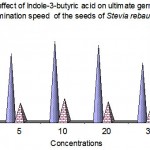 |
Figure 1
|
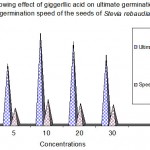 |
Figure 2
|
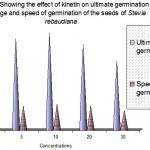 |
Figure 3
|
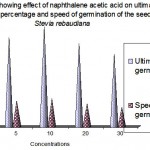 |
Figure 4
|
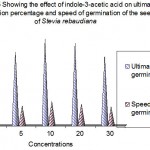 |
Figure 5
|
Conclusions
From laboratory experiment, it is concluded that pre-treatment of Stevia seeds with growth regulators in different concentration showed higher germination percentage and germination speed as compared to untreated seeds. It was also observed that the seed germination percentages in Stevia rebaudiana were decreased regularly on increasing concentrations of growth regulators.
Acknowledgement
The authors are thankful to Prof. Y.D. Tiagi and Prof. N.C. Aery, for their valuable suggestions and encouragement. The authors greatly acknowledge to Mr. Anand Jain for providing seeds and University Grant Commission, New Delhi (India) for the financial help as Meritorious Student Fellowship.
References
- Afzal, I., Basra, S. M. A., Ahmad, N., Cheema, A., Warriach, E.A. (2002). Effect of priming and growth regulator treatment on emergence and seedling growth of hybrid maize (Zea Mays L.) Int. J. Agric. Biol. :303-306.
- Carneiro, J.W.P. (1990). Stevia rebaudiana (Bert.) Bertoni , production of seed . M.Sc Thesis, State University of Marina, Brazil (English abstr.)
- Dahiya, O.S. and Kumari, P. (2007). Seed germination: optimum temperature, moisture and light. In Research Methods in Plant Science by S.S.Narwal, B.Polityka and C.L.Goswami. Sci. Publishers, Jodhpur ,India. Vol., 5: 2-26.
- Debeaujon, I. and Koornneef, M. (2000). Gibberelling requirement for Arabiodopsis seed germination is detrmined both by testa characteristics and embryonic abscisic acid. Plant Physiol. 122 : 415-424.
- Dhankar, D.S. and Singh, M. (1996). seed germination and seedling growth in aonla as influenced by gibberellic acid and thiourea. Crop Res. 12 :363-366.
- Duke, J. (1993). Stevia rebaudiana . In. J. Duke, CRC Handbook of Alternative Cash Crops. Press, Boca Raton, FL. 42-424.
- Gottemoeller, J. and Ching, A. (1999) Seed germination in Stevia rebaudiana Perspective on New Uses. J. Janik (ed), ASHS Press, Alexandria, VA.pp 510-515.
- Groot , S.P.C. and karseen , C.M. (1987). Gibberellin regulate seed germination intomato by endosperm weakening : a study with gibberellin deficient mutants Planta 171 : 525-531.
- Hanson,J. R., and De Oliveira, B. H. (1993). Stevioside and related Sweet Diterpenoid Glycoside. Net. Pod. Rep. 10: 301-309.
- Laster, T. (1999). Stevia rebaudiana (Sweet Hony leaf). The Australia New Crop. Newsletter: Issue No.11.
- Megeji, N. W., Ahuja, P. S., Mishra, Nidhi. (2005). Introducing Stevia rebaudiana anatural zero calorie sweetener. Institute of Himalaya Bioresource Technology, Palmpur. India. Curreent Science 88(5).
- Misra, R. (1968). Ecology Work Book. Calcutta, Mombay, New Drlhi.
- Mohanty, S. K., and Sahoo, N. C. (2006) Effect of soaking period, seed size and growth regulators on imbibition and germination of seed of some field crop. Orissa Journal of Agriculyural Research. Pub. CAB Abstracts.
- Shock, C.C. (1982). Experiment cultivation of Rebaudi’s Stevia in Califofnia. Uni. California Davis Agron. Prog. Rep. 122.
- Shuping, C. Shizhen, S. (1995). Study on storage technique of Stevia rebaudiana (English abtr.) Acta Agronomica Sinica 21: 102-105.
- Taize, L.,and Zeiger, E. (2006). Plant Phsiology. Forth Edition.Sinauer Associates , Inc. Publishers, Sunderland, Massa chuseths.
- Yamajguchi, S., Kamiya, Y. (2001). Gigbberllins and light stimulating seed germination. J. Plant Growth Regu. 20: 369-376.

This work is licensed under a Creative Commons Attribution 4.0 International License.





